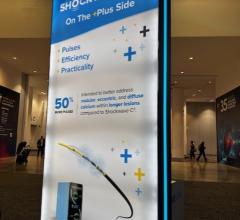
Image courtesy of Abbott Vascular
October 23, 2015 — Results of the TUXEDO trial, designed to compare two types of stents in diabetic patients, found paclitaxel-eluting stents failed to meet non-inferiority criterion compared to everolimus-eluting stents for the primary endpoint of target-vessel failure at one year.
Findings from the trial were reported at the 27th annual Transcatheter Cardiovascular Therapeutics (TCT) scientific symposium, sponsored by the Cardiovascular Research Foundation (CRF), and published in the New England Journal of Medicine.
The optimal drug-eluting stent for coronary artery disease in a diabetic population has often been debated, with contradictory results from past studies comparing paclitaxel-eluting stents versus stents eluting rapamycin analogues (sirolimus, zotarolimus or everolimus). In the absence of an adequately powered study to assess clinical outcomes, a definitive conclusion has not yet been found.
In this investigator-initiated study, 1,830 patients with diabetes mellitus and coronary artery disease undergoing percutaneous intervention at 46 centers in India were randomly assigned to receive either a paclitaxel-eluting stent or everolimus-eluting stent in a non-inferiority trial. The primary endpoint was target-vessel failure defined as a composite of cardiac death, target-vessel myocardial infarction or ischemia-driven target-vessel revascularization at one-year follow-up.
In this trial, paclitaxel-eluting stents did not meet the non-inferiority criterion for target-vessel failure when compared to everolimus-eluting stents at one year (5.6 percent vs. 2.9 percent; relative risk=1.89; 95 percent CI=1.20 to 2.99; risk difference=2.7 percent; 95 percent CI=0.78 percent to 4.48 percent; Pnoninferiority=0.38). Notably, there was a significantly higher one-year rate of target-vessel failure (P=0.005), myocardial infarction (3.2 percent vs. 1.2 percent, P=0.004), stent thrombosis (2.1 percent vs. 0.4 percent, P=0.002), target-vessel revascularization (3.4 percent vs. 1.2 percent; P=0.002) and target-lesion revascularization (3.4 percent vs. 1.2 percent; P=0.002) in the paclitaxel-eluting stent group compared with the everolimus-eluting stent group.
“In patients with diabetes and coronary artery disease, paclitaxel-eluting stents were inferior to everolimus-eluting stents for the primary outcome of target-vessel failure and resulted in higher rates of target-vessel failure, myocardial infarction, stent thrombosis and target-vessel revascularization at one year. Everolimus-eluting stents were superior to paclitaxel-eluting stents for several end points including target-vessel failure, myocardial infarction, and stent thrombosis,” said lead investigator Upendra Kaul, M.D. Kaul is executive director and dean, cardiology at the Fortis Escorts Heart Institute and Fortis Vasant Kunj in New Delhi, India.
“The TUXEDO trial supports the efficacy and safety of limus-eluting stents over paclitaxel-eluting stents in diabetics. The study also questions the ability to translate the findings of previous trials comparing PCI using first-generation stents to coronary bypass surgery in diabetics, as opposed to the current practice of using second-generation drug-eluting stents,” Kaul said.
The TUXEDO trial was an investigator initiated study sponsored by Boston Scientific Corp. and a commitment to ensure consistent availability of the Xience Prime stent for the trial was provided by Abbott Vascular. Kaul reported research grant and lecture fees from Boston Scientific and lecture fees from Abbott Vascular.
For more information: www.tctconference.com


 May 05, 2025
May 05, 2025 








